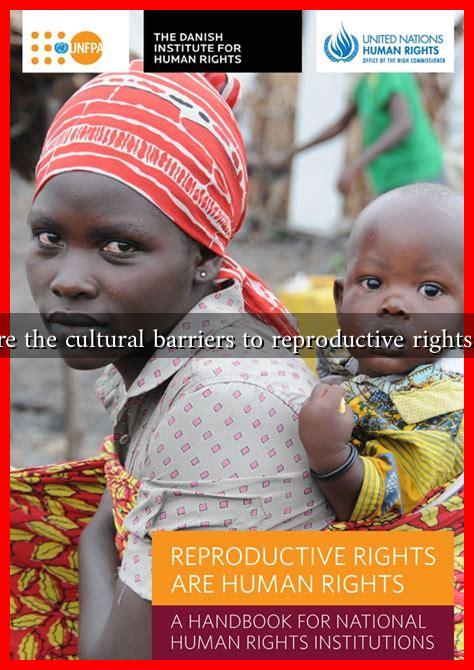-
Table of Contents
- What are the Cultural Barriers to Reproductive Rights Access?
- Understanding Cultural Barriers
- Case Studies: Cultural Barriers in Action
- 1. The United States: The Role of Religious Institutions
- 2. Sub-Saharan Africa: Gender Norms and Stigma
- 3. India: The Intersection of Caste and Gender
- Statistics Highlighting the Issue
- Strategies for Overcoming Cultural Barriers
- Conclusion
What are the Cultural Barriers to Reproductive Rights Access?
Access to reproductive rights is a fundamental aspect of gender equality and personal autonomy. However, various cultural barriers impede individuals from exercising these rights. These barriers can manifest in different forms, including societal norms, religious beliefs, and economic constraints. Understanding these cultural obstacles is crucial for advocates and policymakers aiming to improve reproductive health access globally.
Understanding Cultural Barriers
Cultural barriers to reproductive rights are deeply rooted in the values, beliefs, and practices of a society. They can significantly influence individuals’ perceptions of reproductive health services and their willingness to seek them. Some of the most common cultural barriers include:
- Societal Norms: Many cultures have traditional views on gender roles that dictate women’s responsibilities primarily as caregivers and mothers. This can lead to stigmatization of those who seek reproductive health services.
- Religious Beliefs: In many societies, religious doctrines shape attitudes toward contraception, abortion, and sexual health education. For instance, certain religions may oppose contraceptive use, viewing it as contrary to divine will.
- Economic Constraints: Cultural perceptions of wealth and poverty can also affect access to reproductive rights. In some cultures, discussing reproductive health is seen as a luxury rather than a necessity, leading to underfunded services.
Case Studies: Cultural Barriers in Action
To illustrate the impact of cultural barriers on reproductive rights, consider the following case studies:
1. The United States: The Role of Religious Institutions
In the United States, the influence of religious institutions on reproductive rights is significant. For example, the Catholic Church’s opposition to contraception has led to legal battles over insurance coverage for birth control. According to a 2020 report by the Guttmacher Institute, nearly 20% of women in the U.S. reported difficulty accessing contraceptive services due to religious objections from healthcare providers.
2. Sub-Saharan Africa: Gender Norms and Stigma
In many Sub-Saharan African countries, traditional gender norms dictate that women should prioritize family and child-rearing over personal health. A study published in the journal Reproductive Health found that women in rural areas often face stigma when seeking family planning services, leading to lower contraceptive use rates. For instance, in Nigeria, only 36% of married women use modern contraceptives, largely due to societal pressures and misconceptions about family planning.
3. India: The Intersection of Caste and Gender
In India, cultural barriers are compounded by caste systems and gender discrimination. Women from lower castes often have limited access to reproductive health services due to both economic constraints and societal stigma. A report by the Population Council found that women from marginalized communities are less likely to receive adequate maternal healthcare, contributing to higher maternal mortality rates.
Statistics Highlighting the Issue
Statistics underscore the urgency of addressing cultural barriers to reproductive rights:
- According to the World Health Organization (WHO), approximately 214 million women in developing countries have an unmet need for modern contraception.
- The United Nations Population Fund (UNFPA) reports that 1 in 4 women worldwide experience violence, which can severely limit their reproductive choices.
- In regions where cultural barriers are prevalent, maternal mortality rates can be as high as 500 per 100,000 live births, compared to 12 per 100,000 in developed countries.
Strategies for Overcoming Cultural Barriers
Addressing cultural barriers to reproductive rights requires a multifaceted approach:
- Education and Awareness: Comprehensive sexual education can help dispel myths and reduce stigma surrounding reproductive health.
- Community Engagement: Involving local leaders and influencers can help shift cultural perceptions and promote acceptance of reproductive rights.
- Policy Advocacy: Advocating for policies that protect reproductive rights and ensure access to services is essential for long-term change.
Conclusion
Cultural barriers to reproductive rights access are complex and multifaceted, deeply embedded in societal norms, religious beliefs, and economic conditions. Addressing these barriers is crucial for ensuring that all individuals can exercise their reproductive rights freely and safely. By understanding the cultural context and implementing targeted strategies, advocates can work towards a future where reproductive health services are accessible to everyone, regardless of their cultural background. For more information on reproductive rights and health, visit the United Nations Population Fund.

